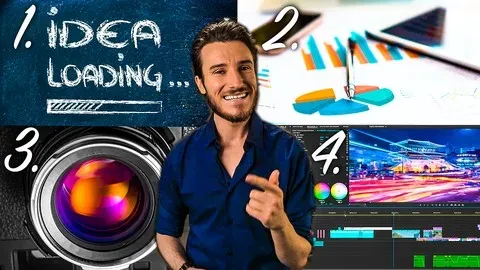
Comprehensive Guide to Final Cut Pro: Part Three

This guide provides an in-depth look at the features of Final Cut Pro, including Titles, Generators, Effects and Transitions. Part Three provides an overview of each of these components.▼
Course Feature
![]() Cost:
Cost:
Free
![]() Provider:
Provider:
Udemy
![]() Certificate:
Certificate:
No Information
![]() Language:
Language:
English
![]() Start Date:
Start Date:
Course Overview
❗The content presented here is sourced directly from Udemy platform. For comprehensive course details, including enrollment information, simply click on the 'Go to class' link on our website.
Updated in [April 29th, 2023]
This course provides a comprehensive guide to Final Cut Pro, Part Three. Students will learn how to use each control in Final Cut Pro, make use of shortcuts to expedite their editing process, and discover Final Cut Pro tools that can help them save time and effort. They will become familiar with the entire Final Cut Pro workflow, from import to export and everything in between. Additionally, they will learn how to adapt to and resolve common problems that arise when editing videos, as well as extend their vocabulary with useful terms from the world of video editing.
[Applications]
After completing this course, students should be able to apply their knowledge of Final Cut Pro to their own projects. They should be able to use the tools and shortcuts to expedite their editing process, as well as become familiar with the entire Final Cut Pro workflow. Additionally, they should be able to identify and resolve common problems that arise when editing videos. Finally, they should have a better understanding of the terminology used in the world of video editing.
[Career Paths]
1. Video Editor: Video editors are responsible for creating and editing video content for a variety of media outlets. They use a variety of software programs, such as Final Cut Pro, to create and edit videos. As the demand for video content continues to grow, the need for skilled video editors is increasing.
2. Motion Graphics Designer: Motion graphics designers use software programs such as Final Cut Pro to create motion graphics for television, film, and other media outlets. They are responsible for creating and animating graphics, as well as creating special effects. As the demand for motion graphics continues to grow, the need for skilled motion graphics designers is increasing.
3. Video Production Manager: Video production managers are responsible for overseeing the entire video production process. They are responsible for managing budgets, scheduling shoots, and ensuring that the video production process runs smoothly. As the demand for video content continues to grow, the need for skilled video production managers is increasing.
4. Video Content Creator: Video content creators are responsible for creating and producing video content for a variety of media outlets. They use a variety of software programs, such as Final Cut Pro, to create and edit videos. As the demand for video content continues to grow, the need for skilled video content creators is increasing.
[Education Paths]
1. Bachelor of Arts in Film and Video Production: This degree program provides students with the skills and knowledge necessary to create and produce professional-level films and videos. Students learn about the fundamentals of filmmaking, including cinematography, editing, sound design, and post-production. They also gain an understanding of the business side of the industry, such as budgeting, marketing, and distribution. This degree is ideal for those who want to pursue a career in the film and video industry.
2. Bachelor of Science in Digital Media Production: This degree program focuses on the technical aspects of digital media production, such as video editing, animation, and graphic design. Students learn how to use various software programs to create digital media content, as well as how to manage and distribute it. This degree is ideal for those who want to pursue a career in digital media production.
3. Master of Fine Arts in Film and Video Production: This degree program provides students with advanced knowledge and skills in filmmaking. Students learn about the history and theory of film and video production, as well as the technical aspects of the craft. They also gain an understanding of the business side of the industry, such as budgeting, marketing, and distribution. This degree is ideal for those who want to pursue a career in the film and video industry.
4. Master of Science in Digital Media Production: This degree program focuses on the technical aspects of digital media production, such as video editing, animation, and graphic design. Students learn how to use various software programs to create digital media content, as well as how to manage and distribute it. This degree is ideal for those who want to pursue a career in digital media production.
Pros & Cons
-

Excellent course
-

best FCPX course
-

free.
-

No advanced effects course.
Course Provider






